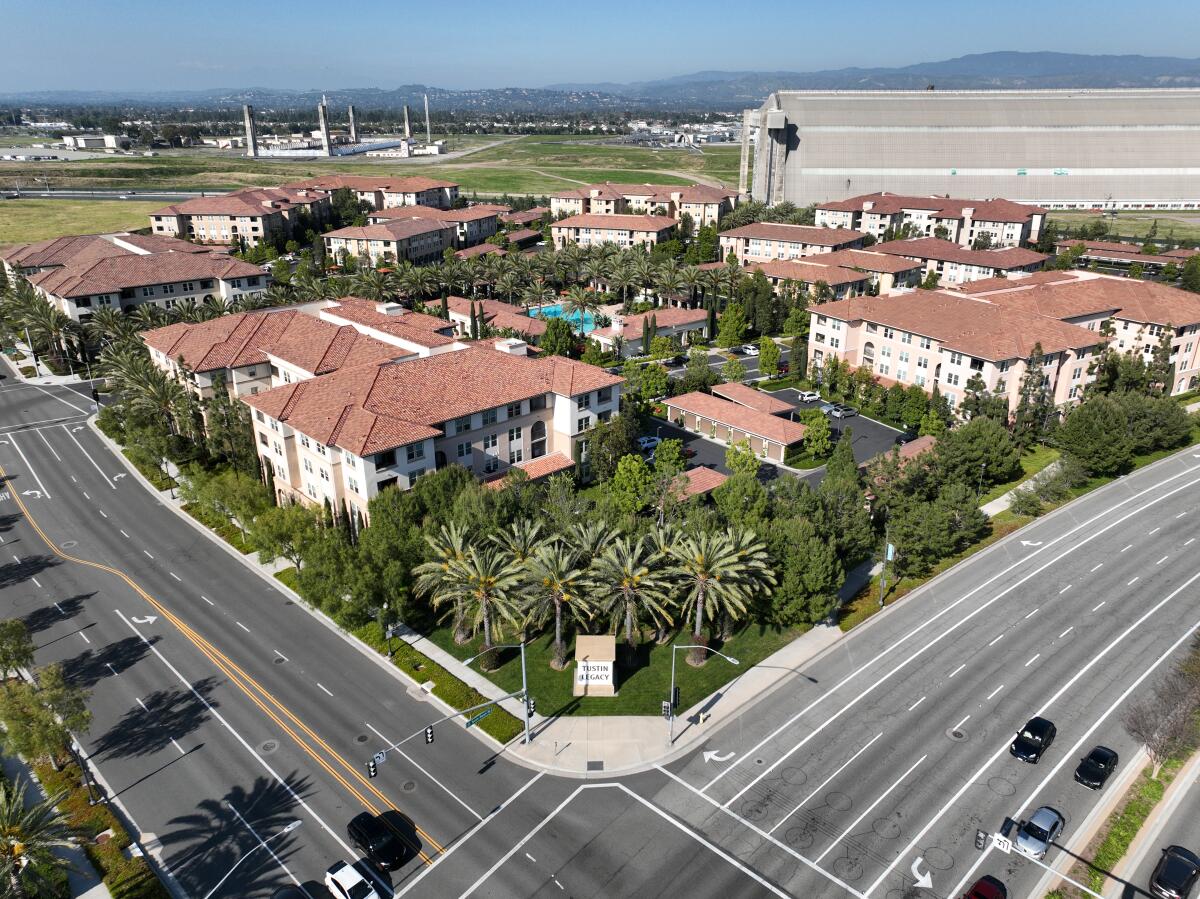Many once-modest California towns have become ‘million-dollar cities’

- Share via
Good morning. It’s Thursday, April 18. Here’s what you need to know to start your day.
- The rise of million-dollar cities in California
- USC valedictorian’s grad speech is canceled
- Eleven sound baths in L.A. to check out
- And here’s today’s e-newspaper
You're reading the Essential California newsletter
Our reporters guide you through our biggest news, features and recommendations every morning
You may occasionally receive promotional content from the Los Angeles Times.
The list of million-dollar cities in California has grown
Do you live in Bonita, Tustin or San Gabriel? If so, congratulations! These once-modest towns have joined the list of California’s “million-dollar cities.”
A “million-dollar city” is any community, town or city where the median value of a home is at least $1 million. And California, as of February, has 210 of them, up 15 from the last count in 2023.
There are currently 550 “million-dollar cities” in the U.S., according to Zillow. California’s share includes cities you’d guess: Beverly Hills, Malibu, Newport Beach and Santa Monica.
But it now also includes cities that until recently were known for their humble working-class stature. California’s rookie “million-dollar cities” include: Bonita, Tustin, Brea, San Gabriel, Cerritos, Orange, San Luis Obispo, Placentia, Cambria, Thousand Oaks, Pala, Pleasant Hill, Arroyo Grande, Bonsall and Cypress.
That’s not the only way to see how housing costs across the state are skyrocketing. Five cities — La Cañada Flintridge, Irvine, Laguna Niguel, Laguna Hills and Poway — already on the million-dollar-city list, have seen median housing costs increase 12% to 17% per year.
Times data reporter Terry Castleman created two maps that help decipher how California’s housing affordability crisis has transformed the state.
Almost all of California’s “million-dollar cities” are coastal. This isn’t surprising. Houses with an ocean view and close proximity to the beach have consistently been sought-after. A majority of California’s residents live in coastal cities.
In 2020, 26.8 million Californians were living in coastal counties, according to the National Oceanic and Atmospheric Administration’s Office for Coastal Management. That is 67.8% of the state’s total population that year.
Limited supply also heightens the issue. In San Diego County’s unincorporated community of Bonita, for example, surging demand, coupled with limits on construction, “may have also contributed to spiking home values,” Terry noted.
The list’s noncoastal towns are scarce and include Indian Wells ($1.3 million), Tahoe City ($1.1 million), Truckee ($1 million), Granite Bay ($1.1 million) and Homewood ($1.1 million).
Statewide, the median home price increased 33.5% over the last five years. Last year, California’s median home value shot up to $789,000 — a 3.1% increase over a year prior.
According to census data, California’s median household income rose from $71,805 in 2017 to $91,551 in 2022 — about a 27.5% increase. Although this is not the same time period as above, statewide median household earnings do not increase parallel to median house values.
Nationwide, homes are worth 5.6 times more than the median household income — a record high from the previous 4-1 ratio — as of 2022, according to Harvard University’s Joint Center for Housing Studies. California, however, leads the pack as median home values across the state are at least 10 times more than median household earnings.
In Southern California, the unfortunate amalgamation of soaring housing prices, stagnant household incomes and high mortgage interest rates have created the most unaffordable housing market in recent years.
Many cities with the highest change in median home price (51% or more) over five years are in Southern California. The change is especially drastic in cities that used to be affordable for middle-income families.
Median home prices grew by 12% per year in Tustin and Bonita, according to Zillow. In Bonita, specifically, median home values have increased by 65% over the last five years.
Tustin’s median household income is over $100,000. So, according to census data, the average home in Tustin is “worth about 10 times what a household earns,” Terry wrote. The ratio is similar in Bonita.
Although more cities have vaulted into the seven-figure range, cities that were already on the “million-dollar cities” list continue skyrocketing. (Though there are some notable expectations, such as Palmdale, Sacramento and Bakersfield — all with median home values below $500,000.)
Read more about how California’s housing crisis is spreading to neighboring states and why California is still losing Californians.
Today’s top stories

USC valedictorian
- Free speech, campus safety collide in USC’s cancellation of valedictorian speech.
- ‘Let her speak!’ USC campus reels after valedictorian’s speech is canceled.
- USC valedictorian’s grad speech is canceled: ‘The university has betrayed me.’
- Citing safety concerns, USC cancels pro-Palestinian valedictorian’s graduation speech.
- Editorial: USC was wrong to silence its valedictorian.
Unionizing and expansion at Disneyland
- ‘The fairy dust fades away’: Why the people who play Disneyland’s costumed characters are unionizing.
- Disneyland character performers move to unionize: ‘We are the Magic.’
- A huge Disneyland expansion to add new rides, restaurants and hotels wins OK.
- Will Disneyland get an Avatar land? It’s likely. Here’s what else may be in store.
Impeachment trial
- Senate rejects impeachment of Homeland Security Secretary Alejandro N. Mayorkas.
- Impeached Homeland Security secretary navigates working with Republicans who want him out.
- What to know about the Mayorkas impeachment and what comes next.
More big stories
- Avian flu outbreak raises a disturbing question: Is our food system built on poop?
- California is in a jam after borrowing billions to pay unemployment benefits.
- L.A. bookseller went to protect his kids from a fight. He was shot and paralyzed.
- LAPD officer who shot girl in Burlington Coat Factory changing room won’t face charges.
- LAPD is searching for up to 20 suspects linked to ‘flash robberies.’
- L.A. sheriff’s deputy facing felony charges allegedly stole money during traffic stop.
- California’s proposed budget cuts would leave many autistic young adults without a safety net.
- Sundance Film Festival could leave its longtime Park City home in 2027. It would be the end of an era.
- NPR suspends journalist who publicly accused network of liberal bias.
- After five years of closure, ‘glamping’ is back again in Yosemite National Park.
- Dodgers shut out by Nationals, drop another series at home in Landon Knack’s first start.
- A controversial food truck kingpin has been arrested in Stanislaus County on suspicion of theft.
Get unlimited access to the Los Angeles Times. Subscribe here.
Commentary and opinions
- Sammy Roth: Changing our lives is scary. But the climate crisis is way scarier.
- Gustavo Arellano: What’s behind those ‘Shame on you’ billboards in the Coachella Valley.
- Christopher Knight: Camille Claudel’s hand, not her trauma, is at the center of a magnificent Getty Museum show.
- Jackie Calmes: The hush money trial has only just begun, but it’s not a good look for presidential candidate Trump.
- Anita Chabria: Is Trump’s trial just a ‘strange campaign stop’?
Today’s great reads

Preschool? Transitional kindergarten? Is there a difference? Parents are stressing out. California is in the midst of a $2.7-billion initiative to provide an additional year of free, high-quality education during the crucial early years. Yet although transitional kindergarten is a statewide program, the details that often matter most to parents — the balance of play and academics and how the program differs from preschool — vary greatly by district.
Other great reads
- A guide to the preschool and child-care terms you need to know.
- Why doesn’t L.A. have any weed lounges? And other burning weed questions answered.
- How a fugitive killer named ‘Smiley’ vanished from L.A. — only to return and strike again.
- Supreme Court tackles homelessness crisis. What it means for California.
- ‘A great problem’: Could Caitlin Clark make the U.S. Olympic team?
How can we make this newsletter more useful? Send comments to essentialcalifornia@latimes.com.
For your downtime
Going out
- 🧘🏽♀️L.A. has hit peak sound bath. Here are 11 to check out right now.
- 🚴🏽 A library for bike riders brings 250 e-bikes to South Los Angeles.
- 🥢 Your next new hangout: crunchy snacks, sake drinks and a buzzing scene at this Virgil Village izakaya.
- 🎡 L.A. artist Blxst on his Coachella debut and where he’s eating Weekend 2.
Staying in
- 🧑🍳 Here’s a recipe for Zaytinya’s chilled yogurt soup.
- ✏️ Get our free daily crossword puzzle, sudoku, word search and arcade games.
And finally ... from our archives

On this day 118 years ago, the 1906 San Francisco earthquake struck with an estimated magnitude of 7.8. It was followed by major fires that lasted for several days. About 3,000 people died and more than 80% of the city of San Francisco was destroyed.
Have a great day, from the Essential California team
Defne Karabatur, fellow
Kevinisha Walker, multiplatform editor and Saturday reporter
Christian Orozco, assistant editor
Karim Doumar, head of newsletters
Check our top stories, topics and the latest articles on latimes.com.
Sign up for Essential California
The most important California stories and recommendations in your inbox every morning.
You may occasionally receive promotional content from the Los Angeles Times.








